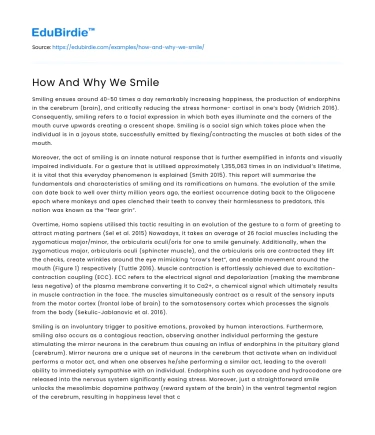Smiling ensues around 40-50 times a day remarkably increasing happiness, the production of endorphins in the cerebrum (brain), and critically reducing the stress hormone- cortisol in one’s body (Widrich 2016). Consequently, smiling refers to a facial expression in which both eyes illuminate and the corners of the mouth curve upwards creating a crescent shape. Smiling is a social sign which takes place when the individual is in a joyous state, successfully emitted by flexing/contracting the muscles at both sides of the mouth.
Moreover, the act of smiling is an innate natural response that is further exemplified in infants and visually impaired individuals. For a gesture that is utilised approximately 1,355,063 times in an individual’s lifetime, it is vital that this everyday phenomenon is explained (Smith 2015). This report will summarise the fundamentals and characteristics of smiling and its ramifications on humans. The evolution of the smile can date back to well over thirty million years ago, the earliest occurrence dating back to the Oligocene epoch where monkeys and apes clenched their teeth to convey their harmlessness to predators, this notion was known as the “fear grin”.
Save your time!
We can take care of your essay
- Proper editing and formatting
- Free revision, title page, and bibliography
- Flexible prices and money-back guarantee
Overtime, Homo sapiens utilised this tactic resulting in an evolution of the gesture to a form of greeting to attract mating partners (Sel et al. 2015) Nowadays, it takes an average of 26 facial muscles including the zygomaticus major/minor, the orbicularis oculi/oris for one to smile genuinely. Additionally, when the zygomaticus major, orbicularis oculi (sphincter muscle), and the orbicularis oris are contracted they lift the checks, create wrinkles around the eye mimicking “crow’s feet”, and enable movement around the mouth (Figure 1) respectively (Tuttle 2016). Muscle contraction is effortlessly achieved due to excitation-contraction coupling (ECC). ECC refers to the electrical signal and depolarization (making the membrane less negative) of the plasma membrane converting it to Ca2+, a chemical signal which ultimately results in muscle contraction in the face. The muscles simultaneously contract as a result of the sensory inputs from the motor cortex (frontal lobe of brain) to the somatosensory cortex which processes the signals from the body (Sekulic-Jablanovic et al. 2016).
Smiling is an involuntary trigger to positive emotions, provoked by human interactions. Furthermore, smiling also occurs as a contagious reaction, observing another individual performing the gesture stimulating the mirror neurons in the cerebrum thus causing an influx of endorphins in the pituitary gland (cerebrum). Mirror neurons are a unique set of neurons in the cerebrum that activate when an individual performs a motor act, and when one observes he/she performing a similar act, leading to the overall ability to immediately sympathise with an individual. Endorphins such as oxycodone and hydrocodone are released into the nervous system significantly easing stress. Moreover, just a straightforward smile unlocks the mesolimbic dopamine pathway (reward system of the brain) in the ventral tegmental region of the cerebrum, resulting in happiness level that corresponds to 2,000 chocolate bars or about $30,000 (Li, 2013). Therefore, explicitly portraying how a simple smile can positively impact society, gradually increasing its overall lifespan. Smiling is a phenomenon that is essentially an innate natural response rather than a learnt attribute. This concept is successfully depicted in the research conducted by Professor David Matsumoto about visually impaired athletes and their excruciatingly similar emotions when compared to sighted athletes. More than 4,800 photographs were taken and analysed. According to Dr. Matsumoto, “The statistical correlation between the facial expressions of sighted and blind individuals was almost perfect” (Figure 2) (Matsumoto 2008). This claim is supported in recently born infants (neonatals) and visually impaired infants, as they both smile. Additionally, a smile between an infant and mother is extremely beneficial for both parties as they both experience increased levels of dopamine in the cerebrum.
Dopamine, which is similar to serotonin, is a neurotransmitter (transmits electrical pulses) located in the cerebrum that allows the individual to experience extreme bliss and euphoria. The increase in dopaminergic levels is achieved by the activation of the mesolimbic dopamine pathway allowing the emotive expression of happiness as seen in (Figure 3) (Strathearn et al., 2008). Furthermore, a smile can be faked or performed without a stimulus (not genuine) in order for the individual to mimic the complex emotion of happiness, thus resulting in many physiological reactions of the body including a reduced heart rate. The cerebrum continuously releases dopamine as it’s tricked into believing humour due to the facial muscles contracting. This representation is supported by Dr. Michael Lewis and his claims about the utilisation of Botox in paralysing the corrugator supercilii, orbicularis oculi and oris in individuals thus, halting the act of frowning and increasing the gesture of smiling.
Moreover, all twenty-five patients who received Botox were remarkably less irritable, anxious, and depressed than the other group that hadn’t received Botox treatment (Lewis, 2013). Subsequently, being aware of the causes and effects of smiling is crucial for an individual to sustain a healthy life. This concept of living must be followed as the by-products of a smile results in an emphatic improvement in an individual’s overall lifestyle. Evidently, smiling is an autonomous mechanism that is deeply rooted in humans and their emotions. Hence, positively demonstrating why it’s recommended for individuals to smile so much in everyday society.






 Stuck on your essay?
Stuck on your essay?

